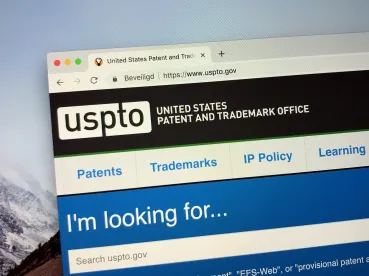Introduction
On January 6, 2022, the U.S. Patent and Trademark Office (USPTO) announced a Deferred Subject Matter Eligibility Response Pilot Program (the “DSMER Program”). We provide a brief overview of this program.
Currently, the USPTO applies a “compact prosecution approach” in examining patent applications. Under this approach, an examiner will identify all applicable grounds for objections and rejections in each Office Action. An applicant is required to address all these objections and rejections in one response. A response that fails to meet this requirement may be considered “not fully responsive” and be rejected by the USPTO.
The DSMER Program allows an applicant to delay responding to one or more Subject Matter Eligibility (SME) rejections under 35 U.S.C. § 101 until the earlier of the final disposition of the application, or the withdrawal or obviation of all other non-SME rejections. For example, for responding to a non-final Office Action that has raised a rejection under 35 U.S.C. §101 (an SME rejection) and a rejection under 35 U.S.C. §102 (a non-SME rejection), the applicant may choose to address only the §102 rejection and defer addressing the §101 rejection.
Eligibility and Participation
A patent application needs to meet the following criteria to be eligible for the DSMER Program:
(a) the application is an original nonprovisional utility application or national stage of an international application;
(b) the application does not claim the benefit of the earlier filing date of any prior nonprovisional application;
(c) the application has not been advanced out of turn; and
(d) the first Office Action on the merits includes both SME and non-SME rejections.
According to conditions (a) and (b), a continuation/divisional application will be ineligible to the DSMER Program since it claims priority to another nonprovisional application (its parent application). On the other hand, a national stage application that claims priority to an international application (i.e., a PCT application) or an application that claims priority to a provisional application is eligible.
According to condition (c), an application that is granted a special status for expedited processing, such as under Track One or Patent Prosecution Highway (PPH), is ineligible to the DSMER Program.
According to condition (d), the DSMER Program is only open to applications governed by the SME requirements (the requirements of 35 U.S.C. §101). Plant applications and design applications are excluded as they are not governed by the SME requirements.
At this time, participation in the DSMER Program is by invitation only. If an application meets the eligibility criteria, the applicant may receive an invitation to participate. The invitation will be included in the first Office Action on the merits. An applicant receiving an invitation may choose to accept or decline the invitation. An applicant who accepts the invitation needs to file a request form PTO/SB/456 concurrently with a timely response to the first Office Action on the merits to indicate the acceptance.
Duration of the DSMER Program
The DSMER Program is set to run from February 1, 2022 to July 30, 2022. During this period, applicants of eligible applications may receive invitations to participate in the DSMER Program.
Discussions
Under the DSMER Program, if a non-final Office Action has both SME and non-SME rejections, the applicant can respond only to the non-SME rejections. Even with the SME issues deferred, the examiner will still consider whether an applicant’s response to non-SME rejections overcome the SME rejections. The SME issues may be resolved while satisfying the non-SME requirements (this is actually often the case). This improves prosecution efficiency, helps applicants save time and cost, and also keeps the file history clean. However, if the SME issues are not resolved after considering the applicant’s response, the examiner may issue a final Office Action regardless whether any non-SME rejection remains. In this scenario, the applicant loses a chance to respond to the SME rejection at the non-final Office Action stage and have to deal with it at the final Office Action stage. Additionally, since non-SME issues and SME issues are addressed sequentially rather than concurrently, the total prosecution time for those applications may be prolonged.





 />i
/>i

